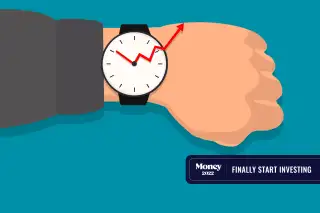5 Stats That Prove You Need to Start Investing Right Now

This article is part of Money's January 2022 digital cover, which features 22 ways to make 2022 the best money year of your life. Browse all 22 articles here.
After plunging in March of 2020, the stock market has regained all of its lost ground — and then some.
The major indices, Dow Jones Industrial Average, S&P 500 and Nasdaq, have all been notching record highs in recent weeks. For the 56% of Americans who have exposure to the stock market, this is great news. But even if you’re not a Wolf of Wall Street type, you can still benefit — without having to go out and purchase stock directly.
Many Americans get exposure to the equities market through a defined-contribution retirement plan like a 401(k) offered by an employer, or an individual retirement account — aka IRA — that gives you simpler, diversified investment options like mutual funds.
For the rest of the folks remaining on the sidelines — what are you waiting for? Take a look at these numbers if you need convincing that now is the time to jump into the investing pool.
$23,082
That’s how much money you could lose out by waiting to start saving for retirement for a single year. According to David Blanchett, head of retirement research at the institutional asset manager QMA, a person who starts putting $5,000 annually into a retirement account at age 25 will have $475,128 saved by the time they turn 65. If that same person held off for just one year—and started contributing $5,000 a year at 26—they'll retire with $452,046. That’s more than $23,000 lost for the sake of a $5,000 initial investment.
$42,231
This would have been your total return if you invested $10,000 in the S&P 500 on January 2, 2001 and didn’t touch it until December 31, 2020, according to calculations from J.P. Morgan Asset Management’s 2021 guide to retirement.
Too many investors get cold feet after a loss and yank their money out — and, as a result, miss out on gains they would have realized when the market recovered.
In the above hypothetical, your return would be chopped by more than half if you missed just the 10 best days for market performance in that two-decade span. In dollar terms, this means finishing up that 20-year run with nearly $20,000 less. The takeaway here? If you panic, you could miss the best earnings opportunities.
6.8%
This is how much prices have increased from November 2020 to November 2021; the highest upswing in the Consumer Price Index since 1982.
Economists wring their hands over inflation because it erodes customers’ buying power. Retirees are especially vulnerable to inflation spikes because, unlike workers, they don’t have a chance at getting raises to offset climbing prices. With the average interest rate for a savings account well under 1%, money socked away in a deposit account just can’t keep up with an employer-sponsored retirement account, IRA or another investment vehicle.
$463,000
Here’s another figure that shows why "staying the course" matters so much. According to the J.P. Morgan retirement guide, an investor who diligently socks away $10,000 annually in their retirement savings for 30 years can net close to a million dollars — even if they get a rocky start. That hypothetical investor would end their 30-year run with $948,000 — even if they take losses in three of their first five years.
Retirement savers who see a few bad years early on can be easily spooked by mediocre returns. But the rate of return right around their retirement date, when they have the most wealth accrued, is much more important.
Consider the same investor, but with the scenarios reversed: Soaring returns for the first five years but losses in three of the last five. They would wind up with $485,000 — or $463,000 less than the investor in the first example.
$135,700
This was the average IRA balance at the end of the third quarter of 2021 — a record high, according to Fidelity Investments. Third-quarter 401(k) contributions also grew by a record 9.4%, Fidelity found.
Sometimes, “everybody’s doing it” is a poor excuse. Other times, it just makes sense.
More from Money:
5 Crypto Buzzwords Everyone Should Know in 2022
Watch Out: These High-Risk Investments Will Be All the Rage in 2022